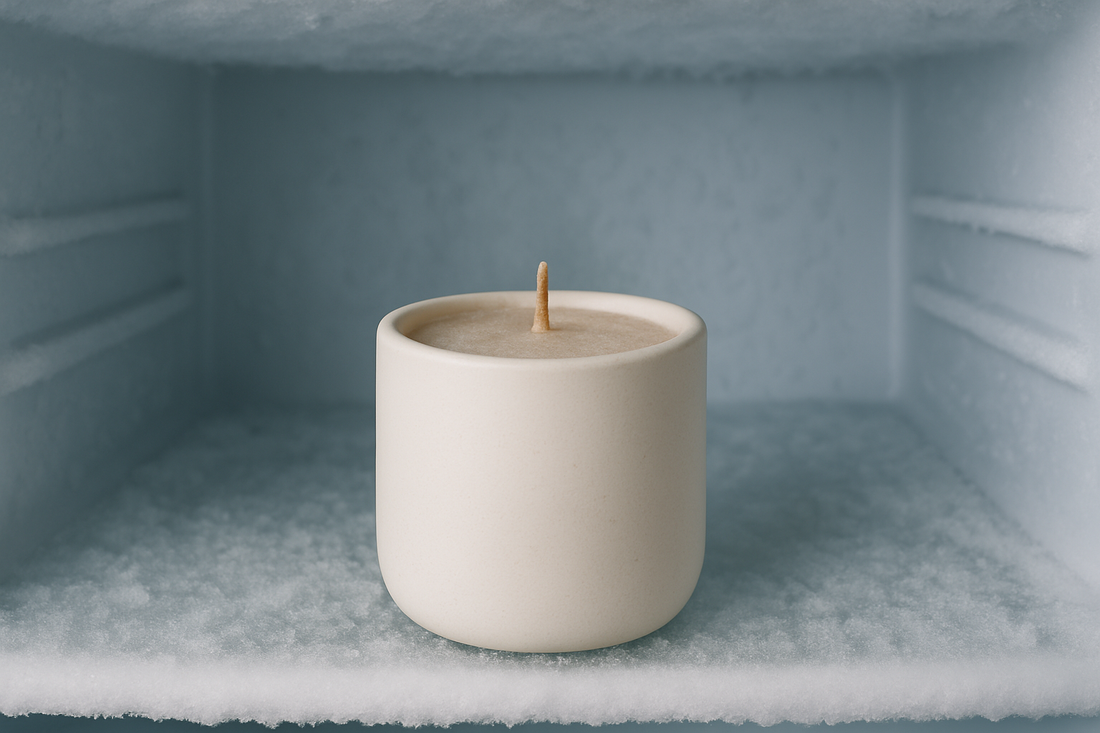You may have seen it on TikTok or Reddit: freeze your candles before lighting them to make them last longer. The idea sounds simple (and a little genius). But is it actually safe—or effective?
Let’s break it down: what really happens when you freeze a candle, what science has to say, and how to get a longer burn without turning your candle into an ice cube.
What’s the Claim Behind Freezing Candles?
The theory goes like this: if you freeze a candle, the wax hardens, and harder wax burns more slowly. This would mean you get a longer-lasting candle and more bang for your buck. For budget-minded, DIY-loving, or eco-conscious shoppers, that sounds like a win.
But like many viral “hacks,” the truth is a little messier than a neatly frozen wick.
The Science — Can Candle Wax Truly “Freeze”?
Candle wax doesn’t freeze the same way water does. Most waxes—including soy wax—have a much higher freezing point. Instead of freezing solid, they just get really cold and hard. That might sound harmless, but the reality is: cold wax behaves differently when you light it.
- When you freeze a candle, a few things happen:
- The wax contracts and pulls away from the container
- Air pockets can form between the wax and jar
- Fragrance oils may separate or concentrate unevenly
- The cold wax can crack, especially on the surface
And when you light a cold, cracked candle? You might get tunneling, uneven burns, or worse—wax splatter and flame flares. Not exactly the cozy vibe you were going for.
Myth vs. Data — Does Freezing Extend Burn Time?
Here’s where it gets interesting. In a real-world test from House Digest, a frozen candle did burn around 5 hours longer than the identical one kept at room temp. Sounds promising, right?
Well—sort of.
The test only involved two candles. It didn’t account for wax type, scent oils, or vessel material. And it didn’t assess how well the frozen candle burned. A longer burn doesn’t mean a better burn if the wax tunnels, the scent fades, or the flame sputters the whole time.
The Risks — When Freezing Backfires
Let’s talk about what could go wrong (and often does):
Cracking & Air Pockets: As wax contracts, it may fracture or pull away from the sides—especially in refillable candles designed to pop out cleanly.
Fragrance Distortion: Freezing can alter how scent oils interact with wax. Result? Weaker hot throw (less scent when burning).
Uneven Burning: Cold wax can cause the wick to work overtime, leading to flare-ups or tunneling.
Vessel Damage: For non-ceramic candles, freezing can stress fragile materials like glass. Luckily, our ceramic candle vessels are heat- and cold-safe up to 2,000ºF—but we still don’t recommend unnecessary stress tests.
Bottom line? That frozen candle might last longer—but at the expense of scent, burn quality, and safety.
ReCandle Co.’s Cold‑Proof Candle Tips
We totally get the appeal of extending your candle’s life. Here’s how to do it—no freezer required:
🔥 Trim Your Wick
Before every burn, trim the wick to ¼ inch. This keeps the flame steady and helps the candle burn cleaner and slower.
🕯 Burn to the Edge
Especially on first light, let your candle burn long enough to create a full melt pool (edge to edge). This prevents tunneling and waste.
🌿 Store Smart
Keep candles out of direct sun or extreme temps (yes, including your freezer). Room temp is ideal for preserving wax texture and scent.
♻️ Choose Refillable
A refillable candle means no more wasting jars or tossing half-burned wax. Just pop in a new soy wax refill and keep the ritual going.
🧪 Want to Experiment Anyway?
If you must test the freeze hack, try this:
- Only freeze for a few hours (not overnight)
- Inspect your wax and wick before lighting
- Avoid if your candle has decorative elements, glass vessels, or high fragrance loads
And don’t say we didn’t warn you!
Final Verdict — Your Candle's Best Burn Strategy
So, does freezing your candle work? Technically—yes, it might extend the burn a bit. But for soy wax candles like ours, it also introduces a bunch of unnecessary risks: from scent fade to wax damage to safety concerns.
At ReCandle Co., our system is built around longevity—just in a smarter, safer, more sustainable way. You don’t need to freeze your candles to make them last. You just need a few good habits, and a clean, refillable system that’s designed to burn better from the start.
FAQ
Can freezing damage my refillable ceramic vessel?
Not likely—our ceramic vessels are safe up to 2,000ºF and very durable. That said, we still don’t recommend freezing as a routine habit.
How long should I freeze a candle if I want to try it?
No more than 1–2 hours. Anything longer increases the risk of cracks or scent issues.
What’s the best way to store soy wax refills?
Room temperature, away from direct sunlight and moisture. Keep them in their recyclable packaging until you’re ready to use.
Ready to make your candle burn better—without the freezer gamble? Check out our zero waste candle refills and see how easy clean burning can be.
